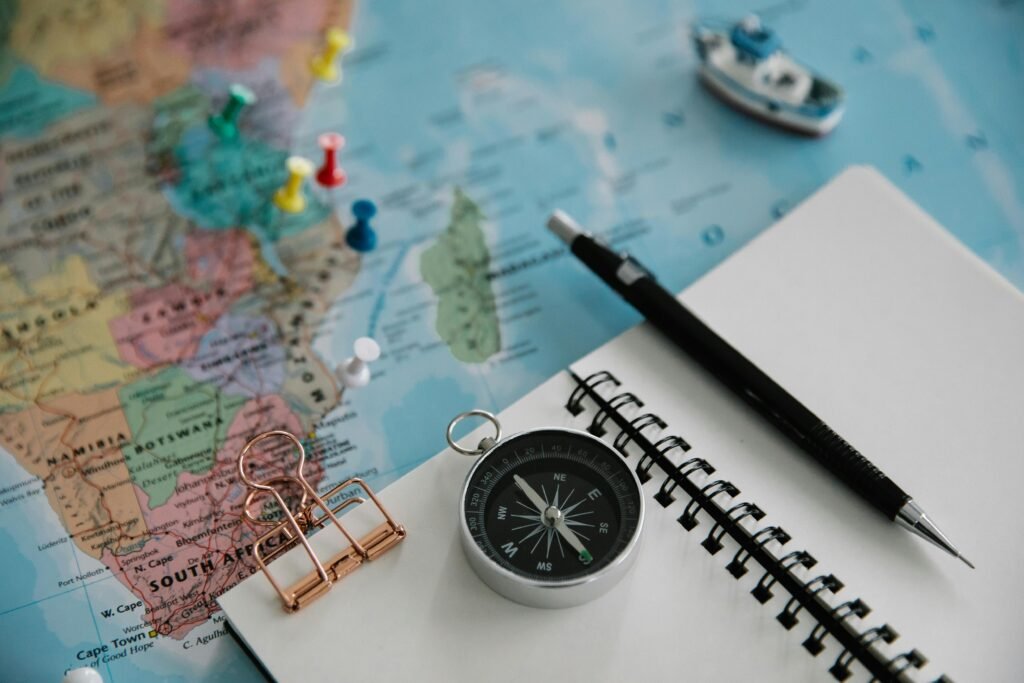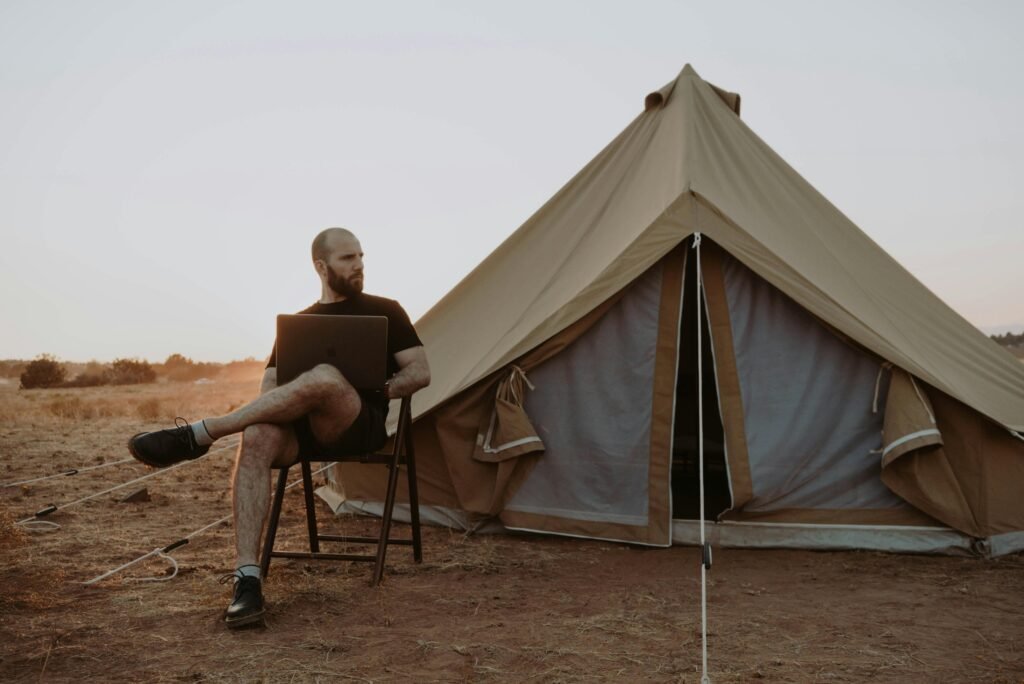Think of travel insurance as your financial backup plan for anything that can go wrong on a trip. It's a policy you buy beforehand that steps in to cover your losses if you hit a snag, whether that's a last-minute cancelled flight, a lost suitcase, or a sudden medical issue far from home.
Breaking Down Your Travel Safety Net

It’s less of a single shield and more like a Swiss Army knife for travel mishaps. A good policy isn't just one type of protection; it bundles together several different coverages, each designed to tackle a specific, common travel headache.
This is a smart approach because any trip carries multiple financial risks. You've got the non-refundable deposits for flights and hotels, the value of everything you packed in your bags, and the potentially staggering cost of getting sick or injured in another country. Travel insurance rolls the solutions to all these problems into one package.
To help you visualize how these different pieces fit together, here's a quick look at the main types of coverage you'll find in a standard policy.
At-a-Glance Travel Insurance Coverage Breakdown
| Coverage Category | What It Typically Covers | Common Scenario Example |
|---|---|---|
| Trip Protection | Your pre-paid, non-refundable trip costs if you must cancel or cut your trip short for a covered reason. | You get sick the day before your flight and can't go. The insurance reimburses your non-refundable hotel and tour bookings. |
| Medical & Dental | Emergency medical or dental treatment you need while traveling. | You break your ankle hiking in the Alps. The policy covers your hospital bills and doctor's fees. |
| Baggage & Belongings | Reimbursement if your checked or carry-on luggage is lost, stolen, or damaged. | The airline loses your suitcase. Insurance helps you buy new clothes and toiletries while you wait or if it's gone for good. |
| Emergency Assistance | 24/7 support services, including medical evacuation to a suitable hospital if needed. | You're in a remote area and need specialized medical care. The policy covers the cost of an emergency flight to a major hospital. |
These core components are why the industry is booming. More travelers are realizing how crucial this protection is. The global travel insurance market was valued at USD 27.05 billion in 2024 and is expected to climb to USD 63.87 billion by 2030. You can discover more insights about this growing market and what's driving the trend.
In essence, travel insurance isn't just one thing—it's a collection of specific protections. Its purpose is to prevent a travel hiccup from becoming a financial disaster, giving you peace of mind from the moment you book your trip until you safely return home.
The Three Pillars of Travel Insurance Coverage
When you start digging into travel insurance, you'll find most policies are built on three main pillars. Think of them as the foundation of your entire safety net. Getting a handle on these is the first real step to picking a plan that actually has your back when you need it most.
These core protections are designed to tackle the most common—and most expensive—travel mishaps. The image below breaks down how these pillars form the base of any solid travel insurance policy.

As you can see, while there might be lots of bells and whistles, almost every policy starts with Trip Cancellation, Medical Coverage, and Baggage Protection.
Trip Cancellation and Interruption
This is the big one for most people. Trip Cancellation is your financial backstop if you have to call off your trip before it even starts. It’s designed to refund you for all those pre-paid, non-refundable deposits for things like flights, hotels, and tours. Of course, you can't just cancel on a whim; it has to be for a reason your policy covers, like a sudden illness or a death in the family.
Let’s say you’ve put down $5,000 on a non-refundable resort package. A week before you’re supposed to leave, your child gets a nasty ear infection and the doctor says flying is a no-go. Without insurance, that money would be gone for good. With trip cancellation coverage, you can file a claim to get that $5,000 back in your pocket.
Trip Interruption is the flip side of that coin. It kicks in after you’ve already left home. If you have to cut your travels short for a covered reason, this benefit helps pay for that last-minute flight back home and reimburses you for the parts of the trip you paid for but will now miss.
Emergency Medical and Dental
This might just be the most important piece of the puzzle, especially if you're heading overseas. A hard truth for many travelers is that your regular health insurance often becomes nearly useless the moment you leave the country. Without the right protection, a simple accident can spiral into a devastating financial burden.
Emergency medical coverage is there for the unexpected—a hospital stay, a doctor's visit, or an ambulance ride after a sudden injury or illness. We're talking about emergencies here, not a routine check-up. Imagine slipping on some cobblestones and breaking your leg. In some parts of the world, surgery and a hospital stay could easily cost you $50,000 or more out of pocket.
It's a common mistake to think travel medical is the same as your health insurance back home. It's not. It's designed for acute emergencies during your trip, with the primary goal of getting you stable enough to fly home, where your regular insurance can take over.
Most good policies also include Emergency Dental coverage. This is typically for accidents, like chipping a tooth on a piece of crusty bread, not for getting a routine cleaning or veneers while you're away.
Baggage and Personal Effects
There’s nothing worse than arriving at your destination only to find out your luggage didn't make the trip with you. This part of your policy gives you a two-pronged defense against baggage blunders.
First up is Baggage Delay. If the airline takes its sweet time getting your checked bags to you (usually after a 12 to 24-hour delay), this benefit lets you go out and buy essential items. You can get reimbursed for things like:
- A fresh change of clothes
- Toiletries like a toothbrush and deodorant
- Any other necessities you need to get by until your bag shows up
Then there's Baggage and Personal Effects Loss. This is for when your luggage is gone for good—stolen, lost, or damaged beyond repair. You’ll be paid back for the value of your belongings, up to the limit set in your policy. Keeping a list of what you packed is a game-changer for making this claim process go smoothly. For some great advice on this, check out our guide on how to pack efficiently, which has tips that double as a good way to create an inventory.
This coverage is more important than you might think. Airlines have a liability cap for lost luggage, which is around $3,800 on U.S. domestic flights, but the stuff inside your suitcase could easily be worth much more. Travel insurance is there to cover that gap.
Tailoring Your Policy: A Look at Specialized Coverage Options
Once you've got a handle on the basics, you can start looking at the add-ons that take a good policy and make it great for your specific trip. Think of a standard policy as a solid, reliable car. These specialized options are the custom upgrades—like adding all-wheel drive for a mountain trip or a premium sound system for a long road trip.
They’re designed to patch up the specific holes that a one-size-fits-all plan might have, turning a general safety net into a shield built just for you. This gives you real peace of mind, whether you're climbing a mountain or just having second thoughts.
The Ultimate Back-Out Plan: Cancel for Any Reason
One of the most sought-after upgrades is Cancel for Any Reason (CFAR) coverage. Your standard trip cancellation is pretty strict; it only kicks in for a specific list of reasons, like a documented illness or a hurricane hitting your resort. CFAR throws that list out the window.
With this add-on, you can cancel for reasons that wouldn't normally be covered. A last-minute work project, a falling out with your travel buddy, or even just a simple change of heart—it doesn't matter. It’s the ultimate escape hatch for life's unpredictability.
Just know that CFAR isn't a "get all your money back" card. It typically reimburses between 50% and 75% of your prepaid, non-refundable costs. But when the alternative is losing everything, getting most of your money back is a huge win. Also, it’s a time-sensitive purchase; you almost always have to add it within 10-21 days of making your first trip payment.
Getting You Out When It Matters Most: Medical Evacuation
If your idea of a vacation involves straying far from city centers and tourist hubs, Medical Evacuation coverage is an absolute must-have. While most policies include some form of it, the limits can be low and the terms restrictive.
Picture this: you're hiking a remote trail in Peru and take a bad fall. The "nearest adequate facility" might be a small rural clinic unprepared to handle a severe injury. A specialized, high-limit evacuation plan ensures you're transported to a top-tier hospital, even if that means chartering a private medical flight across continents.
This is a non-negotiable for anyone exploring the best adventure travel destinations where quality medical care is sparse. A medical airlift can easily run over $100,000, so this coverage isn't just a convenience—it's a financial lifesaver.
Other Smart Add-Ons for Your Trip
Beyond those two heavy hitters, a few other riders can be incredibly useful depending on your plans. Each one plugs a very specific, and very common, travel gap.
- Rental Car Collision Damage Waiver: This lets you confidently decline that expensive insurance they push on you at the rental counter. It provides primary coverage if your rental car is damaged or stolen, often with better terms and for a fraction of the cost.
- Identity Theft Protection: Traveling means using unfamiliar Wi-Fi and swiping your card in new places, which bumps up your risk of identity theft. This add-on provides services to help you sort out the mess if your personal information gets stolen on the road.
- Adventure Sports Coverage: Don't just assume your bungee jumping or scuba diving is covered. Many high-adrenaline activities are explicitly excluded from standard plans. An adventure sports rider extends your protection to cover the risks that come with climbing, diving, and jumping your way around the world.
By really thinking through where you're going and what you'll be doing, you can pick and choose the options that matter. This is how you build a truly personalized policy that gives you rock-solid protection without making you pay for coverage you'll never need.
Understanding Common Policy Exclusions

Knowing what your travel insurance covers is great, but the real test often comes down to understanding what it doesn't cover. Every policy has a list of exclusions—the specific situations and events your plan simply won’t pay for. They're all there in the fine print.
Think of your policy as a safety net. The exclusions are the holes in that net. If you know where they are beforehand, you can avoid falling through them. Ignoring them is a surefire way to get a claim denied, leaving you with the exact unexpected bills you were trying to prevent.
Pre-Existing Medical Conditions
This is one of the biggest "gotchas" in travel insurance. A pre-existing condition is generally any medical issue you had before you bought your policy. This could be anything from a chronic illness you manage daily to an injury you were treated for months ago.
If that condition flares up while you're traveling, a standard policy will almost certainly deny any related claims. For instance, if you have a known heart condition and need medical care for it in another country, you'll be on your own. The good news? Many insurers offer a "pre-existing condition waiver," but there's a catch: you usually have to buy your policy within 10-21 days of making your first trip payment.
High-Risk Activities And Sports
Are you an adrenaline junkie? Your insurance company probably isn't. While your policy will cover you for a casual swim or a light hike, it draws a hard line when it comes to activities it deems high-risk.
Here are a few things that are almost always excluded:
- Professional Sports: If you're competing for a paycheck or prize money, you're not covered.
- Extreme Adventure: Think wingsuit flying, free-climbing, or scuba diving in underwater caves. These are out.
- High-Altitude Trekking: Many plans have an altitude limit, often around 15,000 feet (4,600 meters). Go higher, and you're likely on your own for medical care.
If you’re planning something adventurous, don’t just hope for the best. You'll need to look for a specialized plan or add an "adventure sports" rider to your policy.
It’s not just what you do, but how you do it. Riding a scooter might seem harmless, but if you have an accident while driving without a valid license or a helmet (if required by law), your insurer has every right to deny your claim.
Foreseeable Events And Known Issues
Insurance is built to protect you from the unexpected. If a problem is already brewing or has been widely announced when you buy your policy, you can't claim for it. This is called a "foreseeable event."
You can't buy a policy on Tuesday to cover your flight cancellation from a major airline strike announced on Monday. It doesn't work that way. The same goes for trying to insure a trip to Florida when a named hurricane is already churning its way across the Atlantic. The risk was already known.
Travelers are getting savvier about these risks. By 2025, it's projected that 62% of travelers will opt for more comprehensive policies with coverage of USD 250,000 or more. That’s a huge shift from the old standard of USD 100,000 and shows how traveler awareness is shaping insurance coverage.
The fine print can feel overwhelming, but knowing what to look for makes it much easier. Here’s a quick-glance table of common exclusions you'll find in many travel insurance policies.
Common Travel Insurance Exclusions to Watch For
| Common Exclusion | What It Means for Your Coverage | How to Mitigate Risk |
|---|---|---|
| Pandemics/Epidemics | Many standard plans exclude events related to pandemics unless you have specific coverage. | Look for policies with pandemic-related benefits or purchase a "Cancel for Any Reason" (CFAR) add-on. |
| Civil Unrest/War | Coverage is usually voided if you travel to a country with active conflict or a government travel warning. | Check government travel advisories before booking and buying insurance. Some specialized plans cover these regions. |
| Reckless Behavior | Injuries or losses sustained while under the influence of drugs or alcohol are not covered. | Be responsible. A night of heavy partying could void your entire medical policy if you get hurt. |
| Unattended Baggage | If your bags are stolen after you left them unattended in a public place, your claim will be denied. | Always keep your belongings within your sight or secured in a locked room or locker. |
| Specific Personal Items | High-value items like expensive jewelry, electronics, or cash often have very low coverage limits or are excluded entirely. | Leave irreplaceable valuables at home. For necessary electronics, consider a separate gadget insurance policy. |
Being aware of these common exclusions before you travel is the key. It helps you either choose a better policy or simply avoid risky situations that could leave you without a safety net.
How to Choose the Right Travel Insurance Policy

Alright, you understand the what and why of travel insurance. Now comes the most important part: picking the right policy for your trip. This isn't about finding the cheapest plan on the market. It’s about finding the perfect fit—a policy that covers the real risks of your specific adventure without making you pay for bells and whistles you don’t need.
Think like an insurer for a minute. Your trip has a unique risk profile built on three key factors: where you're going, how long you'll be gone, and what you plan to do. A long weekend in Lisbon is a world away from a month-long trek through the Andes, and your insurance should reflect that.
Assess Your Trip's Financial Footprint
First things first, you need to figure out how much money is actually on the line. Tally up every pre-paid, non-refundable expense you've already committed to. This is the cold, hard cash you'd lose if you had to cancel at the last minute.
Your list should include:
- Flights and Transportation: Every plane ticket, train pass, and cruise deposit.
- Accommodation: Those non-refundable hotel bookings or vacation rental payments.
- Tours and Activities: Any excursions, theme park tickets, or guided tours you've already paid for.
The final number is your trip cost. This is the single most important figure you'll need when getting quotes. Insuring for too little leaves you vulnerable, but over-insuring just means you're paying a higher premium for no reason. For more great advice on mapping out your expenses, check out our guide on how to plan international travel.
Match the Policy to Your Travel Style
Next, think about how often you pack your bags. A single-trip policy is ideal for that one big vacation a year. It's no surprise they dominate the U.S. market, making up 61.3% of all sales. They’re simple and effective for a specific trip.
But if you’re a road warrior, a digital nomad, or someone who takes multiple trips a year, a single-trip plan is a hassle. An annual or multi-trip policy could save you a ton of money and paperwork. These plans, accounting for the other 38.7% of the market, are becoming more popular as people’s travel habits change.
Choosing the right policy type—single trip, multi-trip, or annual—is the first major decision. It aligns your coverage with your actual travel habits, saving you money and administrative hassle in the long run.
Questions to Ask Before You Buy
Comparing policies can feel like you're drowning in fine print. The best way to cut through the noise is to ask a few targeted questions. Use this checklist as you look at different plans to make sure you're comparing apples to apples.
- What are the medical coverage limits? For international travel, don't even consider a policy with less than $100,000 in medical coverage. Medical care abroad can be shockingly expensive.
- Does it cover pre-existing conditions? If you have a health condition, this is non-negotiable. You’ll need a policy with a pre-existing condition waiver, which you typically have to buy within 10-21 days of making your first trip payment.
- What activities are excluded? Are you planning on skiing, scuba diving, or even just some serious hiking? Standard policies often exclude "adventure sports," so you may need to add a special rider to be covered.
- How high is the deductible? This is what you have to pay out of pocket before the insurance company starts paying. A lower deductible is great, but it means a higher premium. Find a balance you’re comfortable with.
- What does the claims process look like? In a crisis, the last thing you want is a clunky, confusing claims process. Look for providers with 24/7 assistance and a straightforward online system for filing claims.
By taking a clear-eyed look at your trip's cost, your travel habits, and the nitty-gritty details of each policy, you can pick your insurance with total confidence. It’s the best way to make sure your peace of mind is built on a rock-solid foundation.
Filing a Claim Without the Headache
Let's be honest, having great travel insurance is one thing, but actually using it when things go sideways is another. You buy a policy hoping you'll never need it, but knowing exactly what to do when disaster strikes can make all the difference. Think of it like knowing where the fire extinguisher is before a fire breaks out—it replaces panic with a clear-headed plan.
The claims process might look intimidating from the outside, but it really boils down to a few straightforward steps. The secret sauce? Acting fast and keeping your paperwork in order. There's a reason most travel insurance providers have a 24/7 assistance line; make it your first call the moment you're in a jam.
Your First Critical Actions
The second an incident occurs—whether it’s a sudden illness, a stolen wallet, or a flight that’s been delayed into oblivion—your first move should be to call your insurance provider. Their emergency team is there to point you toward approved hospitals, tell you what documents you'll need, and get the ball rolling on your claim.
Once you’ve made that call, your new job title is "Chief Documentation Officer." This is the single most important part of the process and where many claims fall apart. You need to become a meticulous record-keeper. Save everything. And I mean everything.
- Receipts and Invoices: For every single expense, from doctor’s bills and prescription medications to new clothes you had to buy when your luggage went missing.
- Medical Reports: Any official paperwork from a hospital or clinic that details your diagnosis and the treatment you received.
- Police Reports: Absolutely crucial for any claim involving theft or an accident. Make sure you get one filed right away.
- Communication Records: Jot down notes on who you talked to—at the airline, your hotel, or the insurance company—along with the date and time of the conversation.
The Dos and Don'ts of Filing a Claim
Getting through the claims process smoothly is all about avoiding the common mistakes. Stick to these simple rules, and you'll significantly boost your chances of getting reimbursed without a fuss. The more organized you are, the faster your claim gets processed. It's a bit like how a well-planned trip starts with good prep, which is why our guide on how to make a travel itinerary can be a lifesaver before you even leave home.
Do: Report the incident immediately. Tell your insurer and any relevant authorities (like the airline or local police) as soon as it happens.
Don't: Assume small expenses aren't worth the trouble. Those little costs can add up quickly, and your policy is designed to cover them.Do: Keep every original document and scan or photograph them as digital backups.
Don't: Exaggerate your losses. Insurance companies take this very seriously—it's considered fraud and can get your entire claim thrown out.
Follow these practical steps, and you can navigate the claims process with confidence, ensuring your travel insurance delivers the peace of mind you paid for.
Frequently Asked Questions About Travel Insurance
Even when you think you've got the basics down, travel insurance can still throw a few curveballs. Let's tackle some of the most common questions that pop up, so you can sort out the details and pick a policy feeling totally confident.
Is Travel Insurance Worth It for Short Domestic Trips?
This really comes down to what you stand to lose. For a quick weekend getaway, think about your non-refundable costs. Did you book a pricey flight or a non-refundable hotel room? If so, trip cancellation coverage could be a lifesaver.
Your regular health insurance will probably cover you medically within the country, but it won't do a thing if your trip gets cut short or you face a major delay.
The real question to ask yourself is: what’s the premium versus the potential hit to my wallet? If losing that money would be a major bummer, a simple policy is a small price to pay for peace of mind.
When Is the Best Time to Buy Travel Insurance?
The golden rule is to buy your policy right after you make your very first trip payment. That could be booking your flight or putting a deposit on your accommodation.
Timing is everything for a couple of big reasons. First, you get the longest possible coverage period for trip cancellation. Anything could happen between booking and departure, and you want to be protected from day one.
More importantly, some of the best benefits are time-sensitive. Add-ons like a waiver for pre-existing medical conditions or a "Cancel for Any Reason" upgrade often require you to buy the policy within 10-21 days of that initial trip deposit. Wait too long, and you might miss out.
How Is Travel Insurance Different From Credit Card Protection?
It’s easy to think the "travel protection" on your credit card is enough, but it's rarely a true substitute for a dedicated insurance policy. Credit card perks are a nice bonus, but they typically have much lower coverage limits and a longer list of what they won't cover.
A standalone travel insurance policy almost always gives you:
- Far higher limits for emergency medical care and medical evacuation.
- More comprehensive trip cancellation and interruption benefits that cover more scenarios.
- Protection against a wider variety of unexpected events.
Think of credit card protection as a safety net with some holes in it; a real insurance policy is the solid ground you want underneath.
Does Travel Insurance Cover Pandemics Like COVID-19?
The travel insurance world has adapted since the pandemic. Today, most plans treat COVID-19 just like any other sudden illness. If you get sick and have to cancel or need medical care on your trip, your benefits should kick in.
What usually isn't covered is canceling because you're worried about a potential outbreak or because of a government travel advisory. That's where a "Cancel for Any Reason" (CFAR) upgrade becomes your best friend, giving you the flexibility to back out no matter the cause. The uncertainty of it all can be tough, and learning how to overcome travel anxiety can also help make the entire experience feel more manageable.
Ready to plan your next adventure with less stress and more confidence? The People Travels uses smart technology to create personalized itineraries that fit your travel style and budget. Stop worrying about the details and start dreaming about your destination. Get your custom travel plan today!




